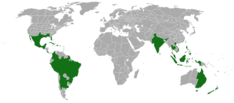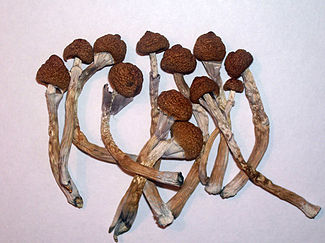- Psilocybe cubensis
-
Psilocybe cubensis 
Scientific classification Kingdom: Fungi Division: Basidiomycota Class: Agaricomycetes Order: Agaricales Family: Strophariaceae Genus: Psilocybe Species: P. cubensis Binomial name Psilocybe cubensis
(Earle) Singer
Approximate Range of Psilocybe cubensis Psilocybe cubensis Mycological characteristics 
gills on hymenium 

cap is convex
or flat

hymenium is adnate
or adnexed
stipe has a ring 
spore print is purple 
ecology is saprotrophic 
edibility: psychoactive Psilocybe cubensis is a species of psychedelic mushroom whose principal active compounds are psilocybin and psilocin. Commonly called Boomers, Cubes or Gold Caps, it belongs to the Strophariaceae family of fungi and was previously known as Stropharia cubensis.
Contents
Taxonomy and naming
The species was first described in 1906 as Stropharia cubensis by Franklin Sumner Earle in Cuba.[1] In 1907 it was identified as Naematoloma caerulescens in Tonkin by Narcisse Théophile Patouillard,[2] while in 1941 it was called Stropharia cyanescens by William Alphonso Murrill in Florida.[3] These synonyms were later assigned to the species Psilocybe cubensis.[4][5]
The name Psilocybe is derived from the Greek roots psilos (ψιλος) and kubê (κυβη),[6] and translates as "bald head". Cubensis means "coming from Cuba", and refers to Cuba, the type locality published by Earle.
Description
- Pileus: 2–8 cm, Conic to convex, becoming broadly convex to plane in age, may retain a slight umbo, margin even, reddish-cinnamon brown when young becoming golden brown in age, viscid when moist, hygrophanous, glabrous, sometimes with white universal veil remnants decorating the cap, more or less smooth. Flesh whitish, bruising blue in age or where injured.
- Gills: Adnate to adnexed to sometimes seceding attachment, close, narrow to slightly wider towards the center, at first pallid to gray, becoming dark purplish to blackish in age, somewhat mottled, edges remaining whitish.
- Spore Print: Blackish violet.
- Stipe: 4–15 cm long, .5–1.5 cm thick, white to yellowish in age, hollow or somewhat stuffed, the well developed veil leaves a persistent white membranous annulus whose surface usually becomes concolorous with the gills because of falling spores, bruising blue or bluish-green when injured.
- Taste: Farinaceous
- Odor: Farinaceous
- Microscopic features: Spores 11.5–17 x 8–11 µm, subellipsoid, basidia 4-spored but sometimes 2- or 3-, pleurocystidia and cheilocystidia present.[7]
It is in the section Cubensae, other mushrooms of this section include Psilocybe subcubensis.
Entheogenic use
Psilocybe cubensis is probably the most widely known of the psilocybin containing mushrooms used. Its major psychoactive compounds are:
- Psilocybin (4-phosphoryloxy-N,N-dimethyltryptamine)
- Psilocin (4-hydroxy-N,N-dimethyltryptamine)
- Baeocystin (4-phosphoryloxy-N-methyltryptamine)
- Norbaeocystin (4-phosphoryloxytryptamine)
The concentrations of psilocin and psilocybin, determined by high-performance liquid chromatography, were determined to be in the range of 0.14–0.42%/0.37–1.30% (dry weight) in the whole mushroom, 0.17–0.78%/0.44–1.35% in the cap and 0.09–0.30%/0.05–1.27% in the stem.[8]
Individual brain chemistry and psychological predisposition play a significant role in determining appropriate doses. For a modest psychedelic effect, a minimum of one gram of dried Psilocybe cubensis mushrooms is ingested orally. 0.25–1 gram is usually sufficient to produce a mild effect, 1–2.5 grams usually provides a moderate effect. 2.5 grams and higher usually produces strong effects.[9] For most people, 3.5 dried grams (1/8 oz) would be considered a high dose and may produce an intense experience; although, typically this is considered a standard dose. For many individuals doses above 3 grams may be overwhelming. For a few rare people, doses as small as 0.25 grams can produce full-blown effects normally associated with very high doses. For most people, however, that dose level would result in virtually no effects. Due to factors such as age and storage method, the psilocybin content of a given sample of mushrooms will vary. Therefore, some users prefer to use a formula or dosage calculator [10] to tailor the dosage to the level they wish to experience.
Effects usually start after approximately 20–60 minutes (depending on method of ingestion and stomach contents) and may last from four to ten hours, depending on dosage. Visual distortions often occur, including walls that seem to breathe, a vivid enhancement of colors and the animation of organic shapes. At higher doses, experiences tend to be less social and more entheogenic, often intense and spiritual in nature.
It is nearly impossible to overdose on psilocybin mushrooms since one would have to consume several dozen pounds of dried mushrooms.[11] Nevertheless, the effects of very high doses can be overwhelming depending on the particular strain, growth method, age at harvest and the individual. Psilocybe cubensis mushrooms can come in rather different sizes. It is recommended that one weigh the actual mushrooms, as opposed to simply counting them. People taking MAOIs need to be careful, as psilocybin and psilocin are metabolized by the enzyme monoamine oxidase. A monoamine oxidase inhibitor reduces the body's ability to metabolize psilocin and psilocybin, greatly increasing the intensity of the experience. This can sometimes produce uncomfortable or undesirably intense experiences.
Medicinal use
Further information: Psylocibin#Use in medicineAlthough there have been limited medical trials due to illegality, the alkaloids in the mushroom, most notably psilocybin along with other psychedelic compounds such as LSD could potentially be a promising treatment for cluster headaches, a chronic and debilitating condition that negatively affects the quality of life of its sufferers.[12]
It is also possible that the mushrooms could be used in psychedelic therapy; one study found that supervised use of these mushrooms could induce a positive mystical experience in participants,[13] which would be desirable in supporting psychotherapy techniques. However, due to its reputation as an illegal substance, its status as a medicine has not yet reached mainstream acceptance.
Legality
It is illegal in many countries to possess psilocybin-containing mushrooms or mycelium (which can contain psychoactive substances at certain stages). However, it is legal in most places to own and sell the spores of these mushrooms. In the United States, only the psychoactive compounds (see above) are scheduled under federal law. The spores do not contain either; however, possession of spores is prohibited by state law in Idaho and Georgia; while California does not prohibit their possession, they do have a law specifically preventing possession with intent to produce psilocybin mushrooms.[14]
Cultivation
Personal-scale cultivation of Psilocybe cubensis mushrooms ranges from the relatively simple and small-scale PF Tek and other "cake" methods, that produce a limited amount of mushrooms, to advanced techniques utilizing methods of professional mushroom cultivators, such as Paul Stamets. These advanced methods require a greater investment of time, money, and knowledge, but reward the diligent cultivator with far larger and much more consistent harvests.
See also
Notes
- ^ Earle FS. "Algunos hongos cubanos" (in Spanish). Información Anual Estación Central Agronomica Cuba 1: 225–42.
- ^ Patouillard NT (1907). "Champignons nouveaux du Tonkin" (in French). Bulletin de la Société Mycologique de France 23 (1).
- ^ Murrill WA (1941). "Some Florida Novelties". Mycologia 33 (3). JSTOR 3754763.
- ^ "Naematoloma caerulescens Pat. 1907". MycoBank. International Mycological Association. http://www.mycobank.org/MycoTaxo.aspx?Link=T&Rec=521843. Retrieved 2010-10-18.
- ^ "Stropharia cyanescens Murrill 1941". MycoBank. International Mycological Association. http://www.mycobank.org/MycoTaxo.aspx?Link=T&Rec=290107. Retrieved 2010-10-18.
- ^ Cornelis, Schrevel (1826). Schrevelius' Greek lexicon, tr. into Engl. with numerous corrections. p. 358. http://books.google.ca/books?id=2eUIAAAAQAAJ&pg=PA358&lpg=PA358&dq=%CE%BA%CF%8D%CE%B2%CE%B7&source=bl&ots=lH1aZtP1bC&sig=aQBAyXnb-pnaocp8rD32S0jAEHk&hl=en&ei=fuovTdfQEcXpgQfq5sCECw&sa=X&oi. Retrieved 2011/10/04.
- ^ Stamets, Paul (1996). Psilocybin Mushrooms of the World. Ten Speed Press. pp. g. 108. ISBN 0-89815-839-7.
- ^ Tsujikawa K, Kanamori T, Iwata Y, Ohmae Y, Sugita R, Inoue H, Kishi T. (2003). Morphological and chemical analysis of magic mushrooms in Japan. Forensic Science International 138(1-3): 85-90.
- ^ Erowid (2006). "Erowid Psilocybin Mushroom Vault: Dosage" (shtml). Erowid. http://www.erowid.org/plants/mushrooms/mushrooms_dose.shtml. Retrieved 2006-11-26.
- ^ Shroomery - Magic Mushroom Dosage Calculator
- ^ Shroomery (2006). "How many dried mushrooms would I have to eat to die from an overdose of psilocybin?". Mind Media. http://www.shroomery.org/9122/How-many-dried-mushrooms-would-I-have-to-eat-to-die-from-an-overdose-of-psilocybin. Retrieved 2006-11-26.
- ^ Erowid (2009). "Cluster Headaches Treatment with Psilocybin" (shtml). Erowid. http://www.erowid.org/plants/mushrooms/mushrooms_medical1.shtml. Retrieved 2009-09-06.
- ^ Griffiths RR, Richards WA, Johnson MW, McCann UD, Jesse R (2009). "Mystical-type experiences occasioned by psilocybin mediate the attribution of personal meaning and spiritual significance 14 months later" (shtml). J Psychopharm. http://www.erowid.org/references/refs_view.php?ID=7339. Retrieved 2009-09-06.
- ^ Erowid (2006). "Legality of Psilocybin Mushroom Spores" (shtml). Erowid. http://www.erowid.org/plants/mushrooms/mushrooms_law8.shtml. Retrieved 2006-11-26.
Further reading
- Guzman, G. The Genus Psilocybe: A Systematic Revision of the Known Species Including the History, Distribution and Chemistry of the Hallucinogenic Species. Beihefte zur Nova Hedwigia Heft 74. J. Cramer, Vaduz, Germany (1983) [now out of print].
- Guzman, G. "Supplement to the genus Psilocybe." Bibliotheca Mycologica 159: 91-141 (1995).
- Nicholas, L.G.; Ogame, Kerry (2006). Psilocybin Mushroom Handbook: Easy Indoor and Outdoor Cultivation. Quick American Archives. ISBN 0-932551-71-8.
- Oss, O.T.; O.N. Oeric (1976). Psilocybin: Magic Mushroom Grower's Guide. Quick American Publishing Company. ISBN 0-932551-06-8.
- Stamets, Paul; Chilton, J.S. (1983). Mushroom Cultivator, The. Olympia: Agarikon Press. ISBN 0-9610798-0-0.
- Stamets, Paul (1996). Psilocybin Mushrooms of the World. Berkeley: Ten Speed Press. ISBN 0-9610798-0-0.
External links
- Psilocybe cubensis in Index Fungorum.
- The Shroomery Detailed information about Psilocybe mushrooms including identification, cultivation and spores, psychedelic images, trip reports, a dosage calculator and an active community.
- Mycotopia Web forums dedicated to information/cultivation of Psilocybe cubensis Mushrooms.
- The Ones That Stain Blue Studies in ethnomycology including the contributions of Maria Sabina, Dr. Albert Hofmann and Dr. Gaston Guzman.
- Erowid Psilocybin Mushroom Vault
- PF TEK Psilocybe cubensis growing techniques.
- Timelapse film of Psilocybe Cubensis growing
Psilocybin mushrooms Gymnopilus G. aeruginosus • G. braendlei • G. junonius • G. liquiritiae • G. luteofolius • G. luteoviridis • G. luteus • G. purpuratus • G. sapineus • G. validipes • G. viridans
Inocybe Panaeolus Psilocybe P. argentipes • P. atlantis • P. aucklandii • P. australiana • P. azurescens • P. baeocystis • P. bohemica • P. caerulescens var. caerulescens • P. caerulipes • P. cubensis • P. cyanescens • P. cyanofibrillosa • P. fimetaria • P. galindoi • P. graveolens • P. guilartensis • P. hispanica • P. liniformans var. americana • P. meridionalis • P. mescaleroensis • P. mexicana • P. naematoliformis • P. ovoideocystidiata • P. pelliculosa • P. plutonia • P. quebecensis • P. samuiensis • P. semiinconspicua • P. semilanceata • P. silvatica • P. strictipes • P. stuntzii • P. subaeruginascens • P. subaeruginosa • P. tampanensis • P. villarrealiae • P. weilii • P. weraroa • P. zapotecorum
Other Categories:- Entheogens
- Psychoactive fungi
- Psilocybe
- Psychedelic tryptamine carriers
Wikimedia Foundation. 2010.

